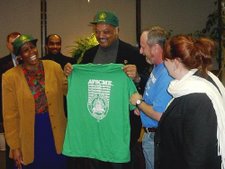 A glistening wind turbine stands outside the
A glistening wind turbine stands outside the Gazing skyward, United Steelworkers president Leo Gerard was impressed. "Twenty-six tons!" he marveled, mentally calculating how many manufacturing jobs that equaled -- before he learned that this particular machine was built in
The scene occurred last fall, when Gerard was on a three-day, three-state barnstorming tour with Sierra Club executive director Carl Pope. They encouraged elected officials to support wind and solar power and energy efficiency as ways of creating jobs, pumping up the
Gerard's United Steelworkers union has been fighting for clean workplaces and communities since the 1960s. It helped pass landmark U.S. legislation regulating air and water pollution and toxic waste, as well as "right-to-know" laws, which require companies to tell the public how much pollution they are releasing. "We need to put an end to the lies, the myths, the hysteria, that say you can have either a clean environment or good jobs," Gerard says. "You can have both, or you have neither."
Gerard's father belonged to a miners' union and held shop-steward meetings in the family basement. He describes himself as an "irreverent" youngster, impatient with high school. "The stuff they were teaching me was how to have a good memory. I resented the system because I thought it marginalized people," he says.
Gerard was elected as United Steelworkers president in 2001, and the irreverent kid who had yearned to become an economics professor was in a position to change the economic future of
While promoting the union's causes, Gerard can be intimidating. Once when it was his turn to speak at a steel company's shareholder meeting, the lights suddenly went out. "This is no time to be f -- -ing with the lights," he barked. "Get them back on or somebody's going to beat the sh -- out of you." Suddenly the room brightened, and Gerard was able to say his piece.
On the first day of their clean-energy tour, Gerard and Pope met with media, workers, environmentalists, and the Twin Cities mayors at the United Auto Workers Hall in
Although the barnstorming tour focused on clean-energy jobs of the future, the union is still working hard to clean up existing workplaces. "Roughly 60,000 workers die each year in this country from workplace accidents or from diseases caused by workplace chemicals," says union environmental specialist Diane Heminway.
In 1990, the Steelworkers published a 34-page manifesto called "Our Children's World." Its message was simple: "We cannot protect Steelworker jobs by ignoring environmental problems." Ahead of its time, the report also warned of the "catastrophic consequences" of global warming. When the document was presented at the Steelworkers' annual meeting, it was not an easy sell.
"We don't say there is never a jobs-versus-environment conflict," says Michael Wright, the Steelworkers' director of health, safety, and environment. "Conflicts may exist, but fighting cleanups is not the way to solve them. Our job is to find solutions that protect both jobs and the environment."
More recently, the union's environmental policies have been questioned by some members of the Paper, Allied-Industrial, Chemical and Energy Workers International Union (PACE), which merged with the Steelworkers in 2005. Paper workers, including loggers and mill workers, are still smarting over environmentalists' efforts to protect the spotted owl in the
Gerard is undaunted by such squabbles. "We aren't going to be united with the environmental movement on every issue," he says. "But we are going to be united 80 or 90 percent of the time. Let's work on that unity rather than let our enemies exploit the divisions."
Gerard's dream of a thriving






No comments:
Post a Comment